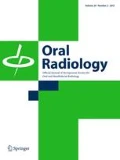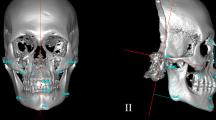Abstract
Objectives
This study aimed to (1) analyze the relationships between mandibular symphysis characteristics (height, prominence, inclination, concavity, and convexity) and facial pattern, skeletal class, lower incisor position, and sex, and (2) determine the associations between the symphysis soft tissue dimensions and the underlying osseous structures.
Methods
Cone-beam computed tomography (CBCT) images were selected for 385 patients (206 women and 179 men). The patients were classified according to their skeletal class and vertical pattern. The lower incisor inclination (IMPA) was recorded. Twelve measurements were taken for each mandibular symphysis using Invivo5 software (Anatomage, San Jose, CA, USA).
Results
Symphyseal measurements were larger in males than in females. Skeletal Class II and III hyperdivergent patients showed the highest symphysis height values. Hypodivergent individuals showed lower symphysis convexity angles. Concavity of the symphysis was greater for Class II hyperdivergent patients. Lower incisor inclination showed a positive correlation with symphysis concavity and inclination. Moderate and weak correlations were found between hard tissue and soft tissue parameters.
Conclusions
Only a few characteristics of symphysis morphology depend on sex, incisor position, skeletal class, and vertical pattern. More significant relationships are found when the vertical pattern and skeletal class are analyzed in combination. The shape of the symphysis soft tissue is not directly correlated with the underlying skeletal structures.




Similar content being viewed by others
References
Nanda RS, Meng H, Kapila S, Goorhuis J. Growth changes in the soft tissue facial profile. Angle Orthod. 1990;60:177–90.
Hoenig JF. Sliding osteotomy genioplasty for facial aesthetic balance: 10 years of experience. Aesthetic Plast Surg. 2007;31:384–91.
Merrifield LL. The profile line as an aid in critically evaluating facial esthetics. Am J Orthod. 1996;52:804–22.
Shindoi JM, Matsumoto Y, Sato Y, Ono T, Harada K. Soft tissue cephalometric norms for orthognathic and cosmetic surgery. J Oral Maxillofac Surg. 2013;71:e24–30.
Buschang PH, Julien K, Sachdeva R, Demirjian A. Childhood and pubertal growth changes of the human symphysis. Angle Orthod. 1992;62:203–10.
Peck H, Peck S. A concept of facial esthetics. Angle Orthod. 1970;40:284–318.
Riedel RA. An analysis of dentofacial relationships. Am J Orthod Dentofacial Orthop. 1975;43:103–19.
Leung CC, Palomo L, Griffith R, Hans MG. Accuracy and reliability of cone-beam computed tomography for measuring alveolar bone height and detecting bony dehiscences and fenestrations. Am J Orthod Dentofacial Orthop. 2010;137:S109–19.
Sun L, Zhang L, Shen G, Wang B, Fang B. Accuracy of cone-beam computed tomography in detecting alveolar bone dehiscences and fenestrations. Am J Orthod Dentofacial Orthop. 2015;147:313–23.
Gu Y, McNamara JA Jr, Sigler LM, Baccetti T. Comparison of craniofacial characteristics of typical Chinese and Caucasian young adults. Eur J Orthod. 2011;33:205–11.
Sherwood RJ, Hlusko LJ, Duren DL, Emch VC, Walker A. Mandibular symphysis of large-bodied hominoids. Hum Biol. 2005;11:735–59.
Talbert L, Kau CH, Christou T, Vlachos C, Souccar N. A 3D analysis of Caucasian and African American facial morphologies in a US population. J Orthod. 2014;41:19–29.
Al-Khateeb SN, Al Maaitah EF, Abu Alhaija ES, Badran SA. Mandibular symphysis morphology and dimensions in different anteroposterior jaw relationships. Angle Orthod. 2014;84:304–9.
Arruda KEM, Valladares-Neto J, Almeida GA. Assessment of the mandibular symphysis of Caucasian Brazilian adults with well-balanced faces and normal occlusion: the influence of gender and facial type. Dent Press J Orthod. 2012;17:40–50.
Swasty D, Lee J, Huang JC, Maki K, Gansky SA, Hatcher D, et al. Cross sectional human mandibular morphology as assessed in vivo by cone-beam computed tomography in patients with different vertical facial dimensions. Am J Orthod Dentofacial Orthop. 2011;139:e377–89.
Tsunori M, Mashita M, Kasai K. Relationship between facial types and tooth and bone characteristics of the mandible obtained by CT scanning. Angle Orthod. 1998;68:557–62.
Yamada C, Kitai N, Kakimoto N, Murakami S, Furukawa S, Takada K. Spatial relationships between the mandibular central incisor and associated alveolar bone in adults with mandibular prognathism. Angle Orthod. 2007;77:766–72.
Yu Q, Pan XG, Ji GP, Shen G. The association between lower incisal inclination and morphology of the supporting alveolar bone–a cone-beam CT study. Int J Oral Sci. 2009;1:217–23.
Molina-Berlanga N, Llopis-Perez J, Flores-Mir C, Puigdollers A. Lower incisor dentoalveolar compensation and symphysis dimensions among Class I and III malocclusion patients with different facial vertical skeletal patterns. Angle Orthod. 2013;83:948–55.
Subtelny JD. A longitudinal study of soft tissue facial structures and their profile characteristics, defined in relation to underlying skeletal structures. Am J Orthod. 1959;45:481–507.
Macari AT, Hanna AE. Comparisons of soft tissue chin thickness in adult patients with various mandibular divergence patterns. Angle Orthod. 2014;84:708–14.
Misch K, Wang HL. Implant surgery complications: etiology and treatment. Implant Dent. 2008;17:159–68.
Mordenfeld A, Andersson L, Bergström B. Hemorrhage in the floor of the mouth during implant placement in the edentulous mandible: a case report. Int J Oral Maxillofac Implants. 1997;12:558–61.
Ricketts RM. Cephalometric synthesis. Angle Orthod. 1961;31:141–56.
Steiner CC. Cephalometrics for you and me. Am J Orthod. 1953;39:729.
Tweed CH. The diagnostic facial triangle in the control of treatment objectives. Am J Orthod. 1969;55:651–67.
Subramaniam P, Naidu P. Mandibular dimensional changes and skeletal maturity. Contemp Clin Dent. 2010;1:218–22.
Acknowledgements
The authors thank William James Packer for translating the manuscript into English.
Author information
Authors and Affiliations
Corresponding author
Ethics declarations
Conflict of interest
Yolanda Gómez, Verónica García-Sanz, Natalia Zamora, Beatriz Tarazona, Carlos Bellot-Arcís, Erik Langsjoen, and Vanessa Paredes-Gallardo declare that they have no conflict of interest.
Human rights statements
All procedures followed were in accordance with the ethical standards of the responsible committee on human experimentation (institutional and national) and with the Helsinki Declaration of 1964 and later versions.
Informed consent
Informed consent was obtained from all patients for being included in the study.
Rights and permissions
About this article
Cite this article
Gómez, Y., García-Sanz, V., Zamora, N. et al. Associations between mandibular symphysis form and craniofacial structures. Oral Radiol 34, 161–171 (2018). https://doi.org/10.1007/s11282-017-0292-x
Received:
Accepted:
Published:
Issue Date:
DOI: https://doi.org/10.1007/s11282-017-0292-x




